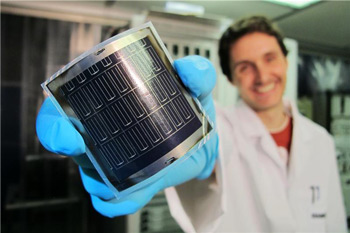Led by Ayodhya N. Tiwari, a team of researchers in the Laboratory for Thin Film and Photovoltaics at Empa (the Swiss Federal Laboratories for Materials Science and Technology) has raised the energy conversion efficiency record for copper indium gallium (di)selenide (CIGS) thin-film photovoltaic solar cells on flexible polymer substrates to 20.4%, as independently certified by the Fraunhofer Institute for Solar Energy Systems (ISE) in Freiburg, Germany.
The lab has previously boosted the efficiency of flexible CIGS solar cells repeatedly, from 12.8% in 1999 (the team’s first record) to 14.1% in 2005, then 17.6% in June 2010, and the team’s existing record of 18.7% in May 2011.
Empa says that, to make solar electricity affordable on a large scale, scientists and engineers the worldwide have long been trying to develop a low-cost solar cell that is both highly efficient and easy to manufacture with high throughput. Tiwari’s team has been investigating various thin-film solar cell technologies for some time.
The latest in the series of records has been achieved due partly to work by PhD students Adrian Chirila and Fabian Pianezzi. The team has modified the properties of the CIGS layer (grown at low temperature) that absorbs light and contributes to the photo-current in solar cells.
Empa’s new efficiency record for flexible solar cells now exceeds the record of 20.3% for CIGS solar cells on glass substrates. It also equals the highest efficiencies for polycrystalline silicon wafer-based solar cells. “We have now – finally – managed to close the ‘efficiency gap’ to solar cells based on polycrystalline silicon wafers or CIGS thin-film cells on glass,” says Tiwari.
Empa says that thin-film, lightweight and flexible high-performance solar modules are attractive for many applications such as solar farms, roofs and facades of buildings, automobiles and portable electronics, and can be produced using continuous roll-to-roll manufacturing processes that offer further cost reductions compared with standard silicon technologies (and hence they have the potential to enable low-cost solar electricity in the near future).

Picture: Flexible CIGS solar cells on polyimide film developed at Empa.
“The series of record efficiencies for flexible CIGS solar cells developed at Empa demonstrates that thin-film solar cells can match the excellent performance of polycrystalline silicon cells,” says Empa’s director Gian-Luca Bona. “Now it is time for the next step, the scale-up of the technology to cover large areas in a cost-efficient roll-to-roll manufacturing process with an industrial partner,” he adds. For this purpose, Empa is collaborating with Flisom, a start-up company involved in the industrialization of flexible CIGS solar cells.
The research work has been supported over the years by the Swiss National Science Foundation (SNSF), the Commission for Technology and Innovation (CTI), the Swiss Federal Office of Energy (SFOE), and the EU Framework Programmes.





